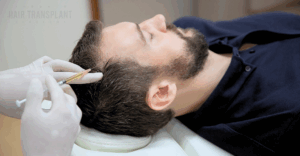VIDEO TRANSCRIPT
Introduction to Hair Restoration
Hair restoration has become a transformative solution for individuals looking to restore hair and regain confidence. At its core, hair restoration involves medical procedures designed to encourage hair growth and improve the appearance of the scalp. One of the most popular and effective options is the hair transplant, which works by relocating healthy hair follicles from one area of the scalp to areas affected by hair loss. This approach is especially beneficial for those experiencing male pattern baldness, but it can also help with other types of hair loss, including those caused by injury or previous surgery.
Advancements in surgical techniques, such as Follicular Unit Extraction (FUE), have made hair transplant surgery more precise and natural-looking than ever before. FUE hair transplants involve extracting individual hair follicles and implanting them into balding areas, resulting in a fuller, more natural appearance. Patients often describe the FUE procedure day as comfortable, with many watching movies or chatting with staff during the surgery. Whether you’re looking to address thinning hair, a receding hairline, or restore hair density, modern hair transplantation offers a reliable path to renewed hair growth and self-assurance.
Understanding Hair Loss
Hair loss is a common concern that can have a significant impact on both appearance and self esteem. The most prevalent form, male pattern baldness, typically begins with a receding hairline and thinning at the crown, gradually progressing over time. This type of hair loss, also known as androgenetic alopecia, is largely influenced by genetics and hormonal changes. Other forms, such as female pattern hair loss and conditions like alopecia areata, can also lead to noticeable thinning or bald patches on the head.
Understanding the underlying cause of your hair loss is crucial when exploring treatment options. For many, hair transplantation offers a permanent solution to restore hair and confidence. However, treatments can also include medications or non-surgical therapies, depending on the type and extent of hair loss. By identifying the specific pattern and cause of thinning, you and your doctor can develop a personalized plan to address your hair restoration goals.
Preparing to Get a Hair Transplant
If you’re considering a hair transplant, preparation is key to achieving the best possible outcome. Start by thoroughly researching the hair transplant procedure and learning about the different techniques available. Finding a highly qualified hair transplant surgeon is essential—look for someone with extensive experience and a track record of successful results.
During your initial consultation, your surgeon will assess your hair loss, discuss your expectations, and recommend the most suitable treatment plan. This is the perfect time to ask questions, express your goals, and ensure you have realistic expectations about the results. Your surgeon will also provide detailed instructions on how to prepare for surgery, which may include adjusting medications or making certain lifestyle changes. Taking these steps will help you feel comfortable and confident as you move forward with your hair restoration journey.
Hair Transplant Clinic
Choosing the right hair transplant clinic is a crucial step in your hair restoration process. A reputable hair transplant clinic will be staffed by highly skilled surgeons who specialize in hair transplantation and hair restoration surgery. When researching clinics, pay attention to their reputation, the qualifications of their doctors, and the range of procedures they offer.
A quality clinic will guide you through the entire process, from your first consultation to post-surgery aftercare. The entire team should be supportive and incredibly helpful, ensuring you feel comfortable and informed at every stage. Comprehensive aftercare and follow-up support are also important, as they contribute to the success of your hair transplant and your satisfaction with the results. By choosing a clinic with experienced surgeons and a patient-focused approach, you can trust that you’re in capable hands throughout your hair restoration journey.
Potential Risks and Side Effects
Like any surgical procedure, hair transplantation comes with potential risks and side effects. Some patients may experience scarring, infection, bleeding, or swelling in the days following their hair transplant. In the first few weeks post-FUE, patients typically experience swelling, redness, and scabbing, which subside within about a week. It’s also common to notice some temporary hair loss or shedding as part of the post op recovery process. While these effects are usually mild and short-lived, it’s important to be aware of them before undergoing the procedure.
Selecting a skilled and experienced surgeon greatly reduces the likelihood of complications. During your initial consultation, your surgeon will discuss these risks with you, answer your questions, and explain how to minimize potential side effects. If a less experienced surgeon over-harvests the donor area in FUE, it can lead to a thinned or “moth-eaten” appearance when hair is cut short. By following your surgeon’s instructions and attending all recommended follow-up appointments, you can help ensure a smooth recovery and the best possible outcome from your hair transplant.
Aftercare and Support
Aftercare and ongoing support are vital to the success of your hair transplant. Once your procedure is complete, your surgeon will provide detailed instructions on how to care for your transplanted hair and scalp. This may include guidance on washing, medications to promote healing, and tips for protecting your new hair during the early stages of growth. Post-operative care is often described as professional and supportive by multiple patients, contributing to a positive recovery experience.
Regular post op check-ins with your clinic allow your surgeon to monitor your progress, address any concerns, and ensure your transplanted hairs are growing as expected. A reputable clinic will offer continuous support throughout your recovery, helping you achieve the best possible results. “Shock loss” of new hair can occur in the first few months post-FUE, which can be distressing but is a normal part of the process. By following aftercare advice and staying in touch with your hair transplant team, you can look forward to healthy hair regrowth and a natural, confident appearance.
VIDEO TRANSCRIPT
Hi, my name is Phil Buckley, and I had my first hair transplant of 2,174 grafts in May 2021, and my second of 1,406 in July of 2023. This is a FUE Hair Transplant Review, and my testimonial aims to provide real patient insight to help you decide if a hair transplant is right for you.
So first off, why did I decide to get a transplant?
Well, my friend Dan and I had joked about getting hair transplants for years as our hairlines continually receded. But a couple of years ago, we shifted from humour to consideration, to serious evaluation. And personally, I had one too many times experienced seeing my reflection and not recognizing the person staring back at me. Who was that old guy? Well, he clearly wasn’t someone I wanted to be. So one night we made a pact. We both decided to invest in hair transplants and scheduled our surgeries on the same day.
So why Dr. Ashlin Alexander?
Our criteria for selecting a surgeon included medical credentials, experience, and personability. Dr. Alexander delivered on all metrics. His extensive training in deep technical and practical knowledge were demonstrated in our initial consultations, as well as his warmth and caring were immediately self-evident. During our consultations, we also discussed additional hair loss treatments like finasteride and minoxidil to help manage ongoing hair thinning and support the transplant results.
So how was my transplant experience?
Well, it was as described by Dr. Alexander with no surprises from a pain perspective. There were a couple of moments where it was discomfort, but they were short and slight, and there was always an offer for extra support as that was happening so that I could get freezing and it wouldn’t be an issue, but it wasn’t required. Also, it was a fun day and talking to the doctor and the technicians was really interesting and enjoyable. Far better than my podcast that I brought thinking I was going to be listening to them. And the healing process was as described as well. The aftercare provided by the clinic was excellent, with ongoing support and guidance throughout my recovery to ensure the best possible outcome.
And on the 11th day, wouldn’t you know it? I needed to facilitate an in-person meeting, which was far earlier than anticipated. And two more days of healing would’ve been better. It would’ve made me feel better, but I was fine, and I could do that with no head cover.
So what were the results?
Well, around the four-and-a-half-month mark, my new hair began to grow. It felt like a miracle to see my new hairline emerge. Also, a cowlick that had frustrated me in my youth was gone. And it felt bizarre to actually go and buy a comb and a gel, which for decades were luxuries I couldn’t enjoy. And looking at myself in the mirror was a joy instead of a disappointment for so many years. And Dan, my buddy, he had the same feeling too.
Also, a welcome surprise that I hadn’t anticipated was that the transplanted hair was darker, which enhanced my younger look. And really it made me feel kind of someone that decades earlier than what I was feeling right now.
And let me show you a comparison to demonstrate the difference between the two different looks. And what you’re seeing right now is on the left was before the transplant. The right was probably about seven months after my first transplant. And these are capture shots from actual Zoom sessions that I was doing with clients. We used before-and-after photos to document the transformation, which really highlights the effectiveness of the procedure. And at least from my perspective, it’s a night and day look of how old I look, but also just the person that I believe myself to be.
The next question is why a second transplant?
Well, as my one-year checkup with Dr. Alexander approached, I decided to see if I could have a second transplant, primarily to extend the new hair growth further back on the top or the crown of my head. And when the doctor confirmed I had enough hair to transplant, I booked the next available date for my surgery.
My second transplant was a breeze and even more enjoyable than the first because I knew what to expect.
And my final question for you is, well, what are my results from my second transplant?
It’s been five months and my hair is growing as I’d hoped, with more hair to grow over the next couple of months, essentially. I’m thrilled.
So this is my story. And in summary, my transplants over-delivered on my expectations. I view them as gifts to myself that I enjoy daily. I look younger, making me feel youthful, vibrant and confident. The hair transplant has truly improved my life and restored my self-esteem. And I really, essentially bottom line is I look like myself thanks to Dr. Alexander.
So I wish you all the best as you consider investing in yourself in this way. And it’s been a pleasure to share my journey. All the best!





